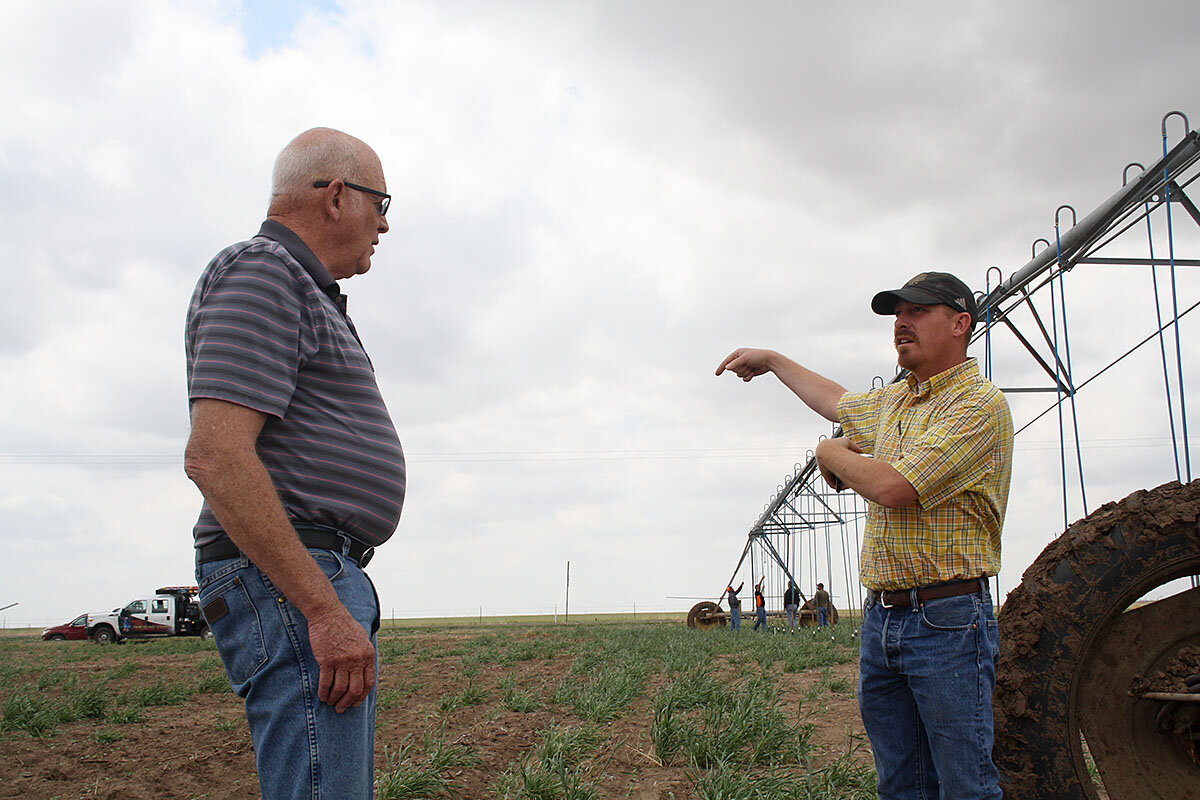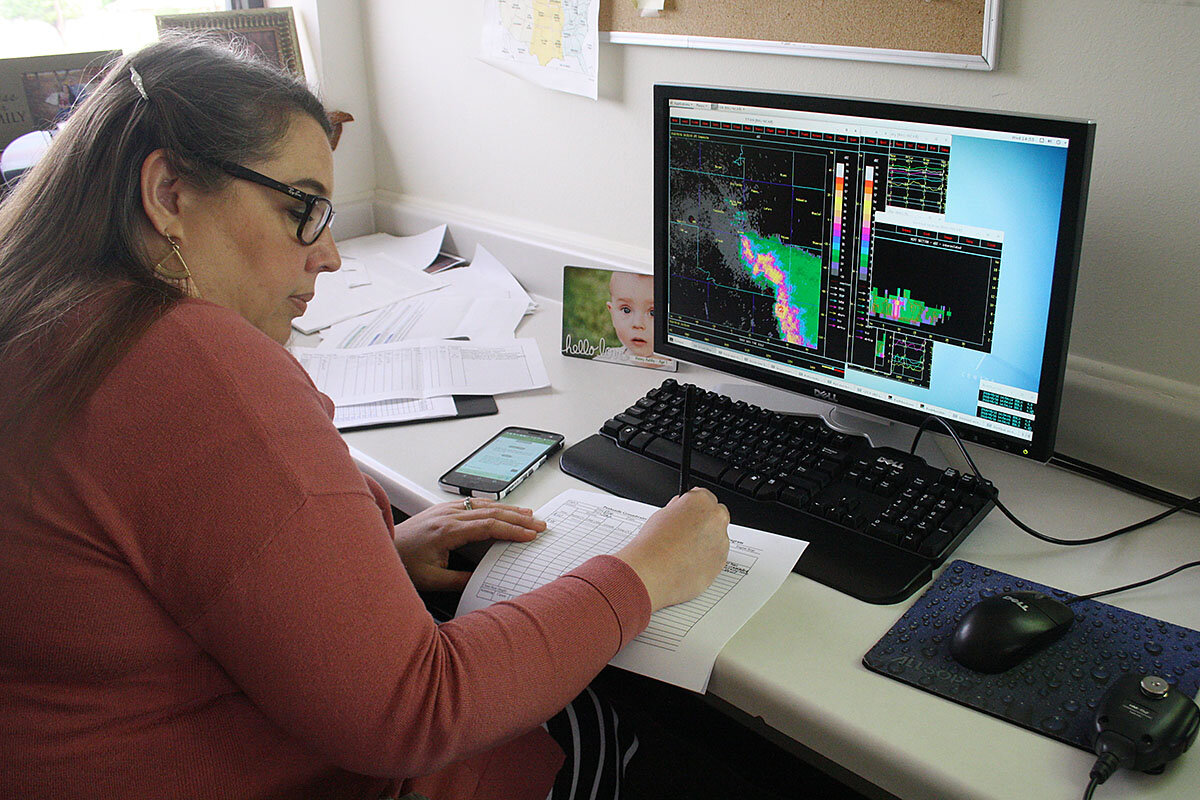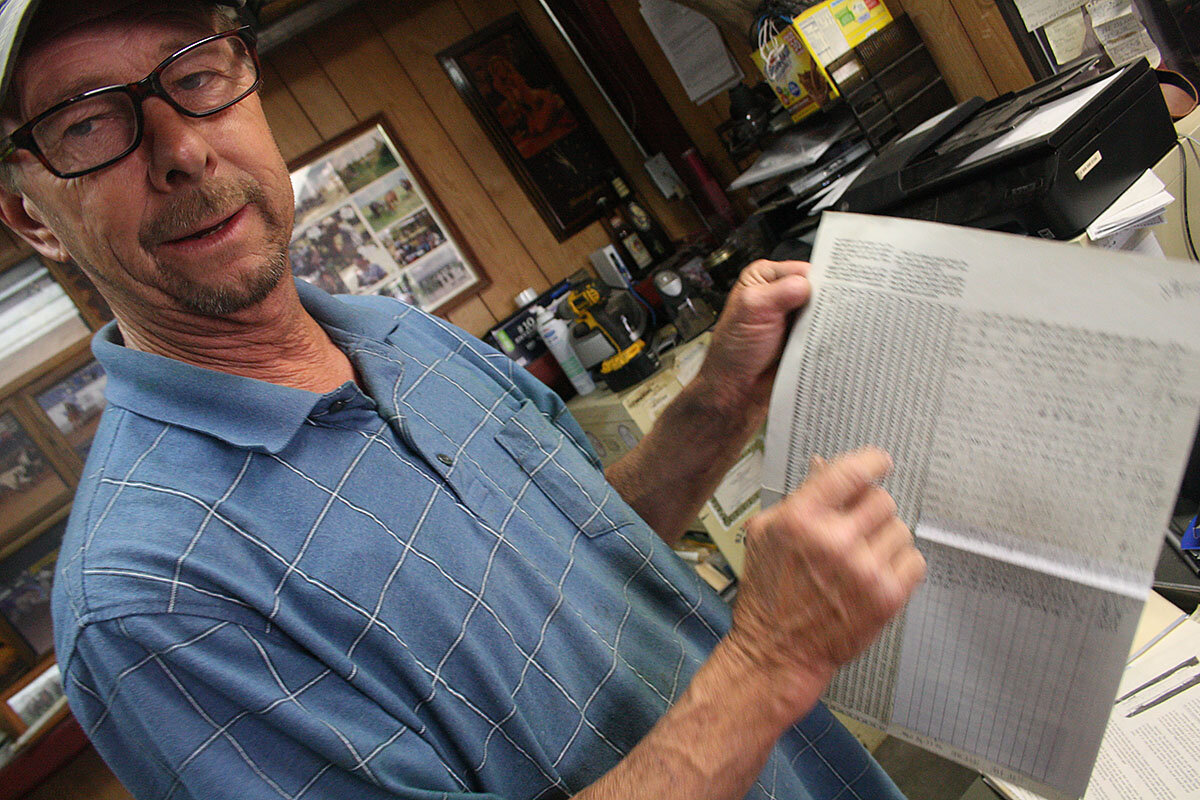It's been seven months since this patch of the Texas Panhandle has seen real rain. Slate-gray clouds now blanket the mid-May morning sky, a glimmer of hope for C.E. Williams. As much as he is thinking about rain – praying for it, really – he’s also thinking about his grandchildren.
Mr. Williams is general manager of the eight-county Panhandle Groundwater Conservation District (PGCD) here, a job he says “is like balancing a balloon on the end of a needle.”
With just 15 to 20 inches of rain during a good year, a fraction of the 60 to 70 inches seen in Houston, Panhandle farmers depend on the Ogallala Aquifer beneath them to sustain their crops. His job is to ensure people are able to use enough of it today to make a living while saving enough for future generations to make a living as well.
“I’ve always thought if I’m doing what’s right for my grandkids in the decisions I make here, that’s probably the right decision,” he says.
There has never been much rain in the Panhandle, and so agricultural production in the region has always required an extra degree of difficulty. Ever since windmill wells allowed settlers to tap into the Ogallala in the mid-1800s, turning what was considered then a great American desert into a new breadbasket, new techniques and technologies have helped the industry survive and thrive.
Today the region is once again in transition. The current drought, which could be devastating on its own, is forcing farmers deeper into the Ogallala. With the aquifer in a state of “managed depletion” in many parts of Texas, farmers are adapting what they grow and how they water it.
“They’ve been really progressive adopters of advanced, efficient irrigation technologies,” says Dana Porter, a professor at Texas A&M University’s AgriLife Extension Center in Lubbock. “There’s a lot of really advanced plant science, soil science, and engineering, that is going into management tools to help these guys improve.”
The overall picture, however, is of a water-poor region that is only going to keep losing water. With a century of economic, political and cultural investment in agriculture, farming in the Panhandle isn’t likely to go extinct. But as farmers scratch their way through this year’s drought, they try to do so without making life harder for their children and grandchildren.
Diversification
Billy Bob Brown grew up with Williams in the small town of Panhandle, 30 minutes east of Amarillo. He’s been farming the dusty soil here since 1972. Corn had always been his favored crop, but in recent years, he’s transitioned most of his rows to the less water-intensive cotton.
“[Cotton] has just offered us a completely different deal,” he says. “Right now it’s the money-maker.”
It takes less than 12 inches per acre to grow cotton, compared with the 30 inches corn demands. He has reduced his water use even more by converting 60 percent of his acreage to “dryland farming,” foregoing irrigation entirely to rely on rainfall. Combined with improvements in irrigation technology on his remaining land, he says he has been able to farm 342 acres with the amount of water his father used on 100 acres.
Mr. Brown sees diversification as the way forward for Panhandle farmers – diversification not only of crops but farming methods and irrigation techniques. Farmers here will always need to irrigate, he says, especially smaller and less experienced farmers. That is something he is thinking about as he prepares to hand over his farm to his grandson. Brown can give him land and equipment, but it feels like every drop of groundwater he uses is a drop his grandson can’t use.
Livelihoods in water and land
About a 10-minute drive from Brown’s house, on another farmer’s cotton field, Williams and the PGCD are testing one new piece of equipment that might be able to make a small but important difference.
Sun and wind have combined to chase away the gray clouds from the morning, and Williams dons sunglasses to inspect a drip irrigation system developed by a Kansas-based company.
For years most farmers have irrigated their crops using a “center-pivot” system – a large rig, outfitted with dozens of dangling hoses, that circles around a field watering everything beneath it. Another method has gained recent favor. With “drip” irrigation, water flows through a perforated hose – sometimes buried under the topsoil – and leaks out into the soil.
The system Monty Teeter, chief executive officer of Teeter Irrigation, is marketing to the PGCD essentially combines the two. Called a “Dragon Line,” it’s an array of orange hoses, each riddled with slits, that the center-pivot rig drags along the soil, leaking water straight into the soil as it goes.
He cuts a hose open to show Williams the emitter inside that controls how much water is allowed to drip out. Spray hoses only hang about knee-high from the ground, but even in those few feet precious amounts of water can be lost to evaporation and the wind. Drip lines would limit those losses, he says, increasing water efficiency anywhere from 25 to 50 percent.
“My thinking is we’re trying to change a culture of irrigation,” he adds. The center-pivot system was a foreign concept to farmers when he began selling them more than 40 years ago, he says, and drip lines could become just as commonplace.
Watching the demonstration, Peter Winegeart, the PGCD’s assistant general manager, notes that farming has always been evolving. To make his point, he points down at his feet to the tufts of wheat stubble in the soil, towering (relatively) over the small green leaves of newly-planted cotton seeds.
“This was put in just to keep the soil in place so it’s not blowing across the Panhandle,” he says. “In the Dust Bowl they plowed everything up and then they realized, ‘Well that was not very smart.’ ”
“You just learn as you go,” he adds.
“They know that their livelihood is the water and the land, and if we don’t use it to the best of our ability then their livelihood’s not there.”
Making do and making rain
With such little water available in the Panhandle – either from the ground or from the sky – Williams and the PGCD are in the business of making the most out of every drop.
Primarily that means extending the Ogallala’s lifespan as long as possible. The PGCD is one of 98 groundwater conservation districts in Texas, and each is required by the state to ensure the users in their jurisdiction withdraw water only within a set limit each year.
For the PGCD, that means trying to limit groundwater withdrawals so that the Ogallala depletes by no more than 50 percent of its 2012 level – which roughly translates to 1.25 percent per farmer per year. Williams likes to think about the Ogallala as a bank account – the trouble is, the sparse rainfall deposits can’t keep up with the rate of withdrawals.
“If you’re taking dollar bills out and putting pennies in, there’s an end of the road at some point in time,” Williams says.
That’s how the PGCD got in the business of making rain.
Jennifer Puryear, a meteorologist, has helped run the district’s cloud-seeding program for a dozen years. She monitors the radar for incoming storm fronts and deploys the districts' two planes to fire flares of silver iodide and calcium chloride into the storm system. Updrafts pull the particles into the clouds, “fertilizing” the clouds, and, by her observations, increasing rainfall in those clouds by 5 to 10 percent, an average of 1.35 to 1.75 inches.
“Five to 10 percent doesn’t seem like a lot, but if you can prevent 5 to 10 percent from being pumped out of the aquifer, to me it’s beneficial,” she says.
One morning in mid-May she is studying live radar images on her computer of a storm system over the district. A transponder radio squawks as she communicates with a pilot who’s just taken off. The system had been there overnight and is now petering out – not the best time to try seeding.
“You really need to be working in the non-drought seasons, because that’s when you get the opportunity to increase your watersheds,” she says.
“The best we can do is just throw out the new technology as much as we can. Stopping farming I don’t think is really an option,” she adds. “All these small towns, that’s what they do. Farm.”
Drop by drop
From windmill wells in the 1800s, to shallow water pumps in the early 1900s, to more powerful centrifugal pumps in the 1950s, farming in the Texas Panhandle has intensified with each new technological breakthrough – with the Ogallala Aquifer the fuel for the agricultural engine.
In recent years farmers have been tapping the brake more when it comes to using water. But while the water is being used more efficiently, there is still a lot more being used than is being recharged.
After a century of agriculture, farming is likely to persist in the Panhandle. And if farmers are saving water through more efficient equipment they tend to use that spare water to increase yields or open another field, rather than leave it in the ground.
The Ogallala isn’t declining uniformly – it is thicker around Amarillo than around Lubbock further south, for example – but groundwater is being pumped out at a rate six times faster than it is being recharged, according to Robert Mace, a water policy expert at Texas State University in San Marcos. Even if that rate slows, so long as withdrawals continue the aquifer “is a finite resource.”
“It’s not evil,” adds Dr. Mace, a former deputy executive administrator of the Texas Water Development Board. “They’re business folks, so they’re looking at the bottom line.”
A transition to a more water-poor future is under way, however. Dryland farming is coming to dominate the southern Panhandle where the Ogallala is thin, and most of the Panhandle is projected to be that way in 50 years.
What seems unlikely is another technological breakthrough that transforms the Panhandle in the way windmill wells and centrifugal pumps did.
“There’s incremental improvements,” like the Dragon Line and cloud seeding, Mace says, “but not this major silver bullet.”
David Hodges has grown enamored with another incremental improvement. Desperate to conserve rainwater a few years ago, he backed an empty tanker truck to the side of his biggest barn, connected a piece of irrigation pipe between the tanker and the barn’s gutter, and left it there during a storm. After 40 minutes, the truck was full.
The next year he bought two 10,000-gallon rainwater storage tanks. Last year he bought another one, and despite getting almost no rain for the past seven months, he has barely had to touch his wells.
“We really have enjoyed those things, but it only works when it rains,” he says one afternoon in mid-May.
Despite the difficult conditions, there are many young farmers in this area east of Amarillo – who haven’t been scared away. Brown’s grandson is one, and Hodges’s son, Destin, is another.
Stocky and tanned, the wide smile on the younger Hodges’s wavers only slightly as he thinks about the Ogallala.
“It’s scary, seeing the water go down,” he says. “You just keep working at it, try to save as much water as you can.”








